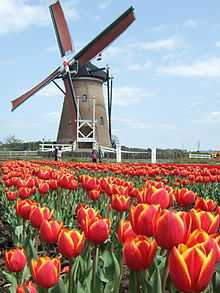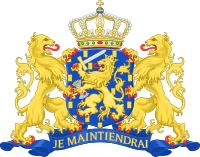Japan–Netherlands relations
 |
|
Japan |
Netherlands |
|---|---|
Japanese–Dutch relations describes the foreign relations between Japan and the Netherlands. Relations between Japan and the Netherlands date back to 1609, when the first formal trade relations were established.[1][2]
History

When formal trade relations were established in 1609 by requests from Englishman William Adams, the Dutch were granted extensive trading rights and set up a Dutch East India Company trading outpost at Hirado. When the Shimabara uprising of 1637 happened, in which Christian Japanese started a rebellion against the Tokugawa shogunate, it was crushed with the help of the Dutch. As a result, all Christian nations who gave aid to the rebels were expelled, leaving the Dutch the only commercial partner from the West.[2] Among the expelled nations was Portugal who had a trading post in Nagasaki harbor on an artificial island called Dejima. In a move of the shogunate to take the Dutch trade away from the Hirado clan, the entire Dutch trading post was moved to Dejima.[3]
Rangaku
Rangaku, literally meaning "Dutch Learning", was the knowledge developed by Japan through its contacts with the Dutch outpost of Dejima. Through this principle of Rangaku, Japan was able to learn about the scientific and technological revolution occurring in the Netherlands and Europe at that time, helping Japan's radical and speedy modernization following the opening of the country to foreign trade in 1854.
Military cooperation
After the forcible opening of Japan by Commodore Perry in 1854 it was decided to modernise the Japanese fleet. To do this orders were placed for modern steam powered warships. The first of which was the ZM SS Soembing, a gift from King William III of the Netherlands, which was renamed the Kankō Maru. To train Japanese sailors in the use of these new and powerful ships the Nagasaki Naval Training Center was established literally right at the entrance of Dejima, to maximize interaction with Dutch naval know-how. Among the students at the Nagasaki Naval Training Center was Enomoto Takeaki, one of the founders of the Imperial Japanese Navy.
World War II

Post war Japanese–Dutch relations
The relations between Japan and the Netherlands after 1945 have been a triangular relationship. The invasion and occupation of the Netherlands East Indies during World War II, brought about the destruction of the colonial state in Indonesia, as the Japanese removed as much of the Dutch government as they could, weakening the post war grip the Netherlands had over the territory. Under diplomatic pressure from the United States, the Netherlands recognised Indonesian sovereignty in 1949 (see United States of Indonesia).
On the 24 August 2009, the Netherlands released a commemorative 5 euro coin to celebrate 400 years of relations.[5]
See also
- Dutch missions to Edo
- Dutch Empire
- Huis Ten Bosch
- Japanese expatriates in the Netherlands
- Category:Foreign relations of the Tokugawa Dynasty(Japanese version)
External links
- The Netherlands–Japan: Collections: the Memory of the Netherlands (het Geheugen van Nederland)
- Japan-Netherlands Exchange in the Edo Period (National Diet Library. Japan)
- Embassy of Japan in the Netherlands (在オランダ日本国大使館)
- Embassy of the Netherlands in Japan
- Japanese business communities in the European Union (plus Switzerland) - an onomastics view (2013)
References
- ↑ Mitsubishi Corporation – Regional Report on the Kingdom of the Netherlands
- ↑ 2.0 2.1 400 jaar handel – Four centuries of Japanese–Dutch trade relations: 1609–2009
- ↑ Edo-Tokyo Museum exhibition catalog, p. 207.
- ↑ Japanese-Netherlands Exchange in the Edo Era: Stranding of De Liefde, retrieved from www.ndl.go.jp, April 14, 2012.
- ↑ (Dutch) News Video of the 5 euro commemorative coin
| |||||||||||||||||||||||||||||||||||||||||||||||||||||
| ||||||||||||||||||||||||||||||||

